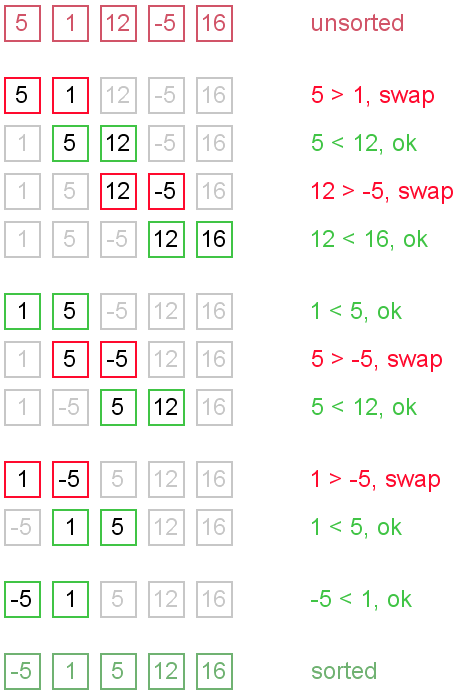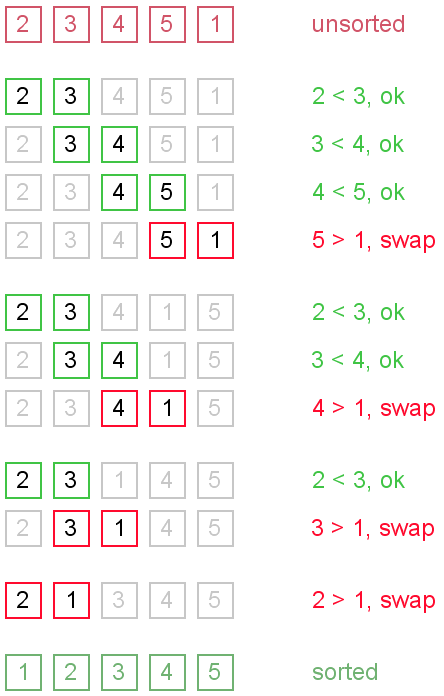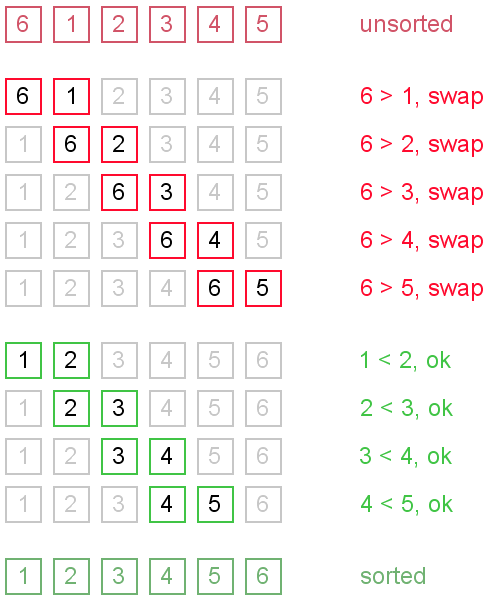Bubble SortBubble sort is a simple and well-known sorting algorithm. It is used in practice once in a blue moon and its main application is to make an introduction to the sorting algorithms. Bubble sort belongs to O(n2) sorting algorithms, which makes it quite inefficient for sorting large data volumes. Bubble sort is stable and adaptive. Algorithm
You can imagine that on every step big bubbles float to the surface and stay there. At the step, when no bubble moves, sorting stops. Let us see an example of sorting an array to make the idea of bubble sort clearer. Example. Sort {5, 1, 12, -5, 16} using bubble sort.
Complexity analysisAverage and worst case complexity of bubble sort is O(n2). Also, it makes O(n2) swaps in the worst case. Bubble sort is adaptive. It means that for almost sorted array it gives O(n) estimation. Avoid implementations, which don't check if the array is already sorted on every step (any swaps made). This check is necessary, in order to preserve adaptive property. Turtles and rabbitsOne more problem of bubble sort is that its running time badly depends on the initial order of the elements. Big elements (rabbits) go up fast, while small ones (turtles) go down very slow. This problem is solved in the Cocktail sort. Turtle example. Thought, array {2, 3, 4, 5, 1} is almost sorted, it takes O(n2) iterations to sort an array. Element {1} is a turtle.
Rabbit example. Array {6, 1, 2, 3, 4, 5} is almost sorted too, but it takes O(n) iterations to sort it. Element {6} is a rabbit. This example demonstrates adaptive property of the bubble sort.
Code snippetsThere are several ways to implement the bubble sort. Notice, that "swaps" check is absolutely necessary, in order to preserve adaptive property. Javapublic void bubbleSort(int[] arr) { boolean swapped = true; int j = 0; int tmp; while (swapped) { swapped = false; j++; for (int i = 0; i < arr.length - j; i++) { if (arr[i] > arr[i + 1]) { tmp = arr[i]; arr[i] = arr[i + 1]; arr[i + 1] = tmp; swapped = true; } } } } Pythondef bubbleSort(L) : swapped = True; while swapped: swapped = False for i in range(len(L)-1): if L[i]>L[i+1]: temp = L[i] L[i] = L[i+1] L[i+1] = temp swapped = True |
|
|||
|
|
|||
隨筆分類(lèi)
隨筆檔案
搜索
積分與排名
- 積分 - 30958
- 排名 - 1362
最新評(píng)論

- 1.?re: Tomcat 6.0配置數(shù)據(jù)源(DBCP)和JNDI使用
- 嗯 萬(wàn)分感謝 ,但問(wèn)下在自己配置的數(shù)據(jù)源中 factory屬性必須添加嗎?我這里有一個(gè)apps就沒(méi)有添加factory屬性,沒(méi)有問(wèn)題。
- --曹夢(mèng)
- 2.?re: 二分查找的優(yōu)化和完備[未登錄](méi)
- 評(píng)論內(nèi)容較長(zhǎng),點(diǎn)擊標(biāo)題查看
- --ray
- 3.?re: 二分查找的優(yōu)化和完備
- 評(píng)論內(nèi)容較長(zhǎng),點(diǎn)擊標(biāo)題查看
- --ytl
- 4.?re: 二分查找的優(yōu)化和完備
- 沒(méi)必要用遞歸吧,還可以?xún)?yōu)化,展開(kāi)成循環(huán)。
- --dennis
- 5.?re: 二分查找的優(yōu)化和完備
- mid比end小吧,end是int型,mid怎么會(huì)溢出呢
- --嚕嚕




